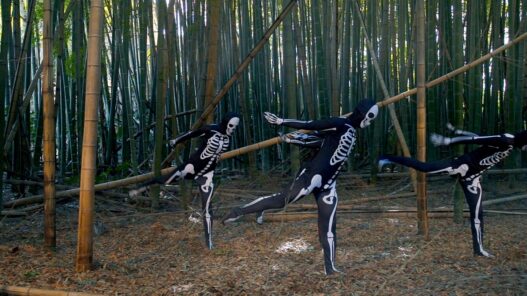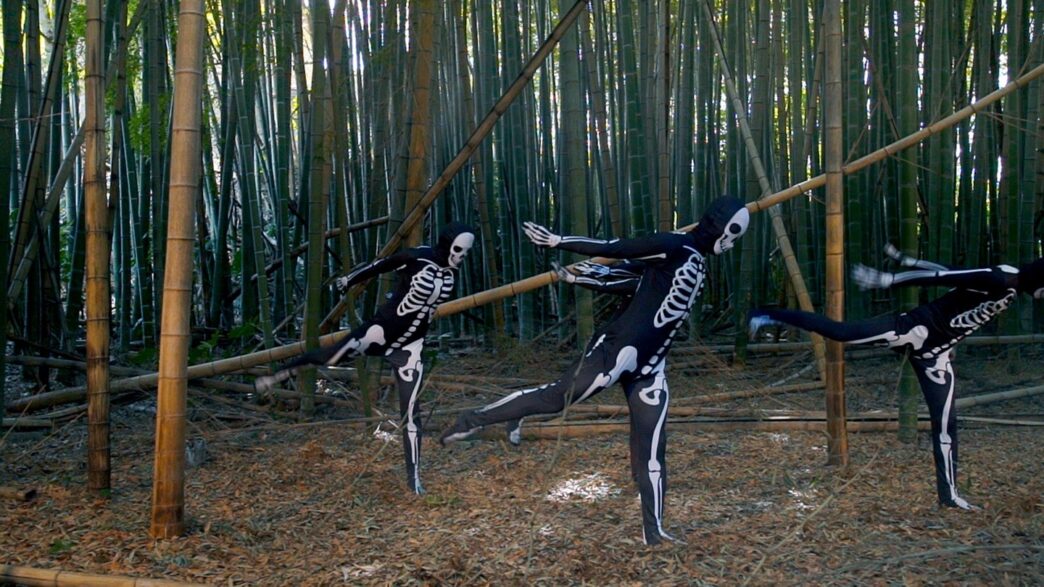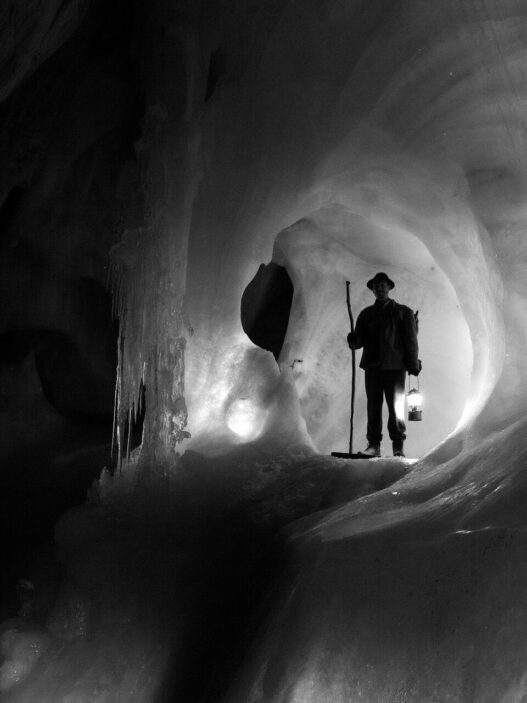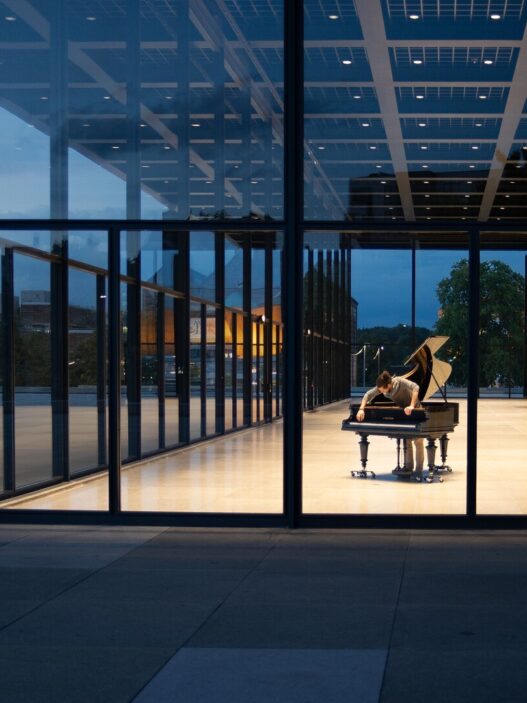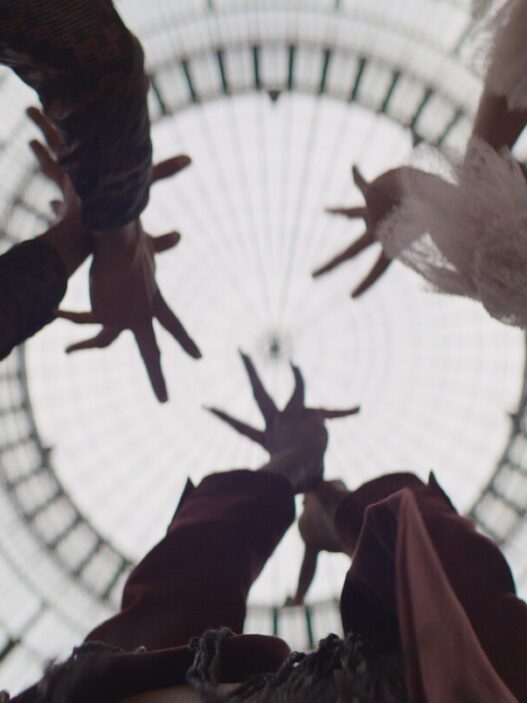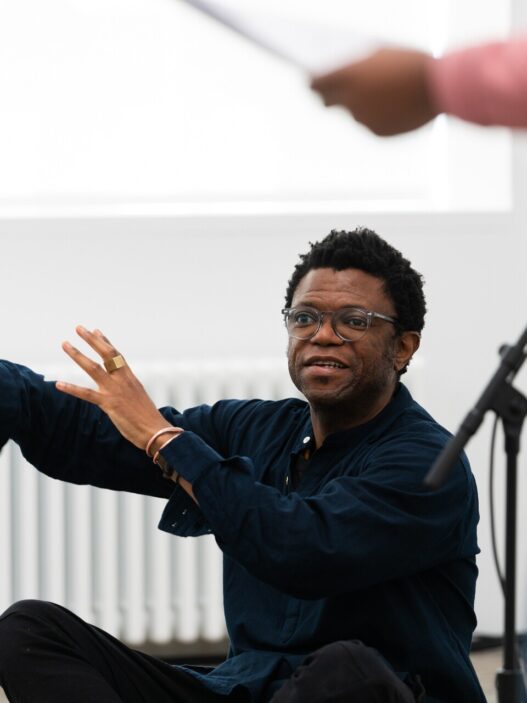October 7, 2022–March 12, 2023
Opening: October 7, 6pm
What if Katarzyna Kobro’s Hanging Constructions were the result of her research into zero gravity and extraterrestrial life? She most likely came into contact with Cosmist concepts, which were talked about in artistic circles in Moscow during the Revolution. And what if Nikolai Fedorov’s writings—which equated the world after the triumph of death and resurrection for all to a museum, a place where time is suspended—were also a factor in motivating Wadysaw Strzemiski to open a museum? These theories link the Muzeum Sztuki’s beginnings to an intellectual movement that started in Russia in the middle of the nineteenth century.
Cosmism holds the belief that technology can enable rebirth. This mental exercise inspired a vision of drastically altered culture and living standards. The theory of Nikolai Fedorov had an impact on subjects as disparate as the Soviet space program, contemporary poetry, constructivism, museology, and even blood transfusion research.
This variety of thoughts and the aesthetics of Cosmism are being introduced in an exhibition at the Muzeum Sztuki, an avant-garde museum. It is based on research done by artist and publisher Anton Vidokle (born 1965), who has spent over ten years studying and working with the Cosmism ideology in an effort to envision a future free of death, violence, degradation, and the exploitation of nature. His films, which were produced in Japan, the Ukraine, Italy, Russia, and Kazakhstan, are on display in the show. They highlight some of the most important ideas from this intellectual and artistic legacy.
The exhibition also showcases pieces from the Muzeum Sztuki’s collection that represent the possessions of an imagined Cosmist International. By highlighting the work of Ukrainian artists who have studied the movement, this exhibition aims to demonstrate that it has not only been present in Russia. A performer, designer, painter, and poet, Fedir Tetyanych was profoundly inspired by the idea of the biosphere. He created the Frypulia doctrine, which was founded on ideas of eternity, infinity, and boundlessness. Veronika Hapchenko, a Krakow-based visionary painter whose works depict diverse elements of Konstantin Tsiolkovsky’s writings, also has paintings on display.
Room 1
Fedir Tetyanych: From Cossacks to Biotechnospheres
Fedir Tetyanych (1942–2007) was an all-encompassing artist whose creations were informed by a nuanced philosophy. He developed his ideas while growing up in the settlement of Kniazhychi, which is close to Kiev. He included folktales, customs, symbols, and mythology from his own Ukraine. Additionally, he associated with the Cossack, a hero who represents individual independence. His interest in modernism, cosmicism, and science fiction was combined with these inspirations, from the physical characteristics of his creations to the underlying ideologies. He used trash as a source of material and added earth to his paint. As a result, he created a gesture in which he attached the entire universe to his canvas.
He gave his computer system the moniker Frypulia, which he occasionally also used for himself. It was a system through which mankind, which emitted both radio waves and light beams carrying all of its information, could be replicated once more at any location in space. As a result, Frypulia conjured forth both infinity and immortal life.
There are three groups of items in this room. One includes a sizable painting of an immortal in an infinite world and pieces on paper tying these futuristic views to Ukrainian history (for example, a Cossack mace forming a biotechnosphere). The second is a collection of paper-based pieces from the series Biotechnospheres: Cities of the Future. The artwork focuses on a unit for human habitation and movement, one of the artist’s primary interests. The biotechnosphere is also linked to the third group. In 1984, one of the vehicle types was coated with the works on paper. They mimic some elements of the pattern.
Room 2
From Zero Gravity to Immortality
Anti-gravity was equated to swimming in the sea in the 1920 science fiction novel Beyond the Planet Earth: “the travelers will dangle, so to speak, in their atmosphere: they will neither fall, nor need the floor for support.” They will move through the water similarly to fish, but without any significant obstructions or water resistance. Katarzyna Kobro’s Hanging Composition 1 (1920–1921) is a piece that ties Suprematism and space travel together.
The item is displayed next to a clip from the essay film Solaris Mon Amour by Kuba Mikurda. This is a fundamentally new interpretation of this science-fiction classic that was created purely from recovered film. Another link between Polish culture and cosmic thought can be found here. The ocean planet in Stanislaw Lem’s novel has the power to bring back “guests” and to bring back the loved ones of the visitors from Earth who have passed away. The illustration of a location where salvation and eternal life are attainable alludes to the agony of World War Two.
Room 3
Anton Vidokle, Citizens of the Cosmos, 2019, 30:19 minutes
Citizens of the Cosmos is a film by Anton Vidokle based on the Biocosmist manifesto, written by Alexander Svyatogor in 1922. Shot on location in Tokyo and Kyiv with a group of amateur actors, volunteers, and extras, the film presents an imaginary community voicing the historical desires of Cosmism—immortality, resurrection of the dead, and interplanetarism—all in the context of everyday life in contemporary Japan. Using urban shrines, cemeteries, a crematorium (actually located in Kyiv), tatami rooms, a bamboo forest, an industrial gas plant, and city streets as an open-air stage, the film gradually narrates the Biocosmist manifesto while presenting a sequence of dream-like tableaux, featuring rejuvenation through blood transfusion, funerary processions and demonstrations, a Danse Macabre, the cremation bone picking ceremony (骨上げ), attempts to communicate with the dead using stethoscopes, and a theremin orchestra recital, among other scenes. Set to an original score composed by Alva Noto, Citizens of the Cosmos is an experiment in defamiliarisation: a speculative test of the universality implicit in Cosmism’s premise.
Room 4
The Central Room
The Cosmism chronology serves as the framework for organizing our understanding of this obscure yet incredibly powerful ideology. It ties together all the exhibition’s components that at first glance could appear to be unrelated to one another. The Cosmist International’s collection of speculative art provides an iconographic constellation that bases the movement’s goals in timeless images of rebirth, death, and space travel. Veronika Hapchenko (born 1995), a painter with roots in Krakow whose works are influenced by the literature of the Cosmists, completes the space with three paintings. To make the images of the future and space appear hazy, she employs an airbrush method. The two major works make use of cosmic visions from Tsiolkovsky’s writings. The smaller work in the middle, influenced by George Gurdjieff, is here a portrait of the resurrected, infinite human being—a gnostic Anthrôpos.
Room 5
Anton Vidokle, Autotrofia, 2020, 31:37 minutes
This movie, which was filmed in the southern Italian village of Oliveto Lucano, offers a fictional tale based on the works of the painters Vassily Chekrygin and Vladimir Vernadsky. It also documents an old pagan fertility ceremony that is being carried out in this area. The movie’s plot examines the ecological aspect of cosmicism, which is the desire for humans to change and evolve so they no longer need to kill and consume other living things in order to obtain the energy they require to survive and can instead learn from plants how to obtain nutrition directly from the sun. This concept, which was first proposed at the turn of the 20th century, is contrasted with an older, pagan celebration of King Oak and King Holly: a harvest festival in which two trees signifying summer and winter are joined into one extraordinarily tall tree, completing and uniting the seasonal cycle produced by our planet’s orbit around the Sun. In partnership with the villagers, Fondazione Matera-Basilicata commissioned Autotrofia. The entire community took part in the production of the movie; some people worked on the set while others played parts. Shot in Italian, the script was translated by Franco (Bifo) Berardi. The music for the film was composed by Alva Noto (Carsten Nicolai).
Room 6
Anton Vidokle, Immortality for All: A Film Trilogy on Russian Cosmism, 2014–17, 96 minutes
Cosmism is a school of thought that has mostly fallen out of favor. Numerous influential Soviet philosophers were inspired by its utopian tenets, which combined Marxism with Russian Orthodox traditions and Western Enlightenment thinking, up until they fell victim to Stalinist repression. Artist Anton Vidokle explores Cosmism’s impact on the 20th century and discusses its continued significance in this three-part film project. He returns to the Cosmist pillars of thought in Part One (This Is Cosmos, 2014). Part Three reenacts the museum as a location of resurrection, a key Cosmist notion (Immortality and Resurrection for All!, 2017), while Part Two examines the connections between cosmology and politics (The Communist Revolution Was Caused By The Sun, 2015).
Vidokle draws on the writings of Cosmism’s founder Nikolai Fedorov and other writers, fusing essay, documentary, and performance. From the steppes of Kazakhstan to the museums in Moscow, his roving camera looks for signs of Cosmist influence in the ruins of Soviet-era art, architecture, and engineering. These eerie visuals are accompanied by music by John Cale and Éliane Radigue, which evokes the Cosmist ideals of interconnectivity, social equality, material transmutation, and immortality.
Individual Synopses
This is Cosmos, 2014, 28:10 minutes
Shot in Siberia and Kazakhstan, as well as the Moscow and Archangelsk regions, the first film in the trilogy on Russian Cosmism comprises a collage of ideas from the movement’s diverse protagonists, including founding philosopher Nikolai Fedorov. Fedorov, among others, believed that death was a mistake—a flaw in the overall design of the human, “because the energy of cosmos is indestructible, because true religion is a cult of ancestors, because true social equality is immortality for all.” For the Cosmists, the definition of the cosmos was not limited to outer space: rather, they set out to create a “cosmos,” or harmonious and eternal life, on Earth. The ultimate goal, as illuminated in the short film, was “to construct a new reality, free of hunger, disease, violence, death, need, inequality—like communism.”
The Communist Revolution Was Caused by the Sun, 2015, 33:36 minutes
The poetic aspect of Soviet biophysicist Alexander Chizhevsky’s solar cosmology is examined in the second installment of the trilogy. The movie introduces us to Chizhevsky’s investigation into the effects of solar emissions on human society, psychology, politics, and economics through wars, revolutions, diseases, and other upheavals. The film was shot in Kazakhstan, where Chizhevsky was imprisoned and then exiled. In order to emphasize that the early Soviet breakthroughs aiming at the conquest of space were less about technical acceleration than about the common cause of humankind in their struggle against the constraints of earthly life, the film aligns the lives of post-Soviet rural folk with the futurological projects of Cosmism.
Immortality and Resurrection for All!, 2017, 34:17 minutes
The trilogy’s last part is a meditation on the museum as the site of resurrection—a central idea for many Cosmist thinkers, scientists, and avant-garde artists. Filmed at the State Tretyakov Gallery, Moscow Zoological Museum, the Lenin Library, and the Museum of Revolution, the film looks at museological and archival techniques of collection, restoration, and conservation as a means of the material restoration of life, following an essay penned by Nikolai Fedorov on this subject in the 1880s. The film follows a cast of present-day followers of Fedorov, several actors, artists, and a Pharaoh Hound, who playfully enact the resurrection of a mummy, and perform close examinations of Malevich’s Black Square, Rodchenko’s spatial constructions, taxidermized animals, artifacts of the October Revolution, skeletons, and mannequins in scenes resembling tableau vivants, in order to create a contemporary visualization of the poetry implicit in Fedorov’s writings.
Curated by Daniel Muzyczuk.
Muzeum Sztuki in Lodz
Wieckowskiego 36 St.
90-734 Lodz
Poland
Hours: Tuesday–Sunday 12am–6:30pm









